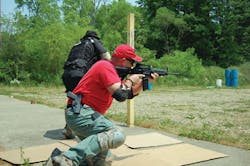“The struggle to be “good enough” to win a violent encounter for your life is based on a lifetime commitment to learning and practice. It is not achieved quickly or easily and is attended to with diligence and dedication. It is not “easy” and is not based on passing minimum qualification standards. It takes work and is promulgated and sustained by an intense will and drive. Head in the game, focused, intent, deliberate, competent and confident. Those of us, who understand, struggle each day with the question, “Am I good enough?” The thunderous answer rings in our ears, “No yet!” But motivates us forward…" - Kevin Davis
I wrote those words one day in frustration with both student’s and instructor’s attitudes toward training and competency levels. Here is why…
The Trainer’s Mission
Training is the lifeblood of law enforcement. The quality, content and frequency of the training we give our officers directly relates to their ability to win the day on the street, in a fight for their life, vehicle pursuit or violent suspect encounter. This is not accomplished by training to “minimum performance levels” and we do our officers and trainees a disservice by doing so. Listen to these words – we do not properly prepare our officers for deadly force street encounters or dynamic situations such as suspect control, emergency response or pursuit driving, building searches on and on – by training to the minimums, nor do we protect the agency from civil litigation. And yet, there are still those delusional trainers and academy commanders in basic training programs who only train their students to pass the state mandated SPO’s (student performance objectives), or administrators and agencies that believe that all they have to do is conduct state required minimum firearm qualification courses once a year or police officer standards and training (POST) dictated in-service programs and they are good to go. Think I’m exaggerating? In a recent conversation I had with an instructor/proponent of an open enrollment state minimum basic academy program, he defended as relevant and realistic the driving program his potential officer/students went through. Even though this training is conducted at low speeds with rental vehicles like PT Cruisers he defended this program. When several of these types of students were recently hired by an active mid-size agency they were given proper training. Most were unable to even parallel park the vehicle. This realistic training included high speed emergency response and pursuit events that better prepared them for the conditions they might actually drive in. This was the first time these officers had driven a police vehicle. Fortunately this relevant and realistic skill training was given to them prior to their first pursuit.
In the firearms, tactics and defensive tactics realms, are the students in these academies or in-service programs truly getting enough repetitions to learn the skills? Or, are they taught just enough to pass the SPO’s? Which may lead to, just enough to get them hurt on the streets? After all, if the instructor makes the program physically demanding there might be injuries and injuries of paying customers doesn’t look good and isn’t good for business. Maximizing profits means filling the class with the max number of students. How many students can run a drill at one time? How much standing around and twiddling their thumbs is there? What is the student/instructor ratio? Enough to ensure that the students get the proper attention they deserve or an accepted, “That’s good enough; you’ve passed the SPO’s.”
The illusion for the students in these programs is that there are properly prepared, the delusion this instructor operates on, and oftentimes when he knows better, is that he’s giving street relevant training.
Feel my words are too harsh? Get over it instructors – lives hang in the balance of the content and quality of the training we give our officers. Quite frankly low-speed maneuverability is not properly preparing your students for the streets. I know many of these types of academies make the instructors money but the question is, is it worth it? This isn’t “T-Ball” where everyone wins and everyone gets a trophy.
The Student’s Mission
Nose to the grindstone you apply yourself to your training. Although the study will take up your entire career, you’ll reap the benefits right away. You invest “sweat equity” to learn the skills to maximize your performance and minimize your risks. By training for and achieving competency you’ll be much better able to control the Sympathetic Nervous System reaction commonly known as “fight or flight.” In this way you’ll perform better physically but also be able to make better cognitive decisions under stress. Does this sound like anything that is possibly accomplished by training to minimum levels? Seek out a mentor or role model. Just as an apprentice carpenter studies under a journeyman, you too should seek out those competent and confident instructors or practitioner/officers whose skill you want to emulate. Hold your instructors accountable. As long as you’re doing your part by applying yourself, you have the right to say to the instructor, “This is not relevant. There is too much downtime. I need more time and repetitions.” Be professional, be respectful but hold them accountable. If you are paying your own way (paying the instructor’s salary) then express your concerns to the academy commander. Do not accept driving programs conducted with leased compact cars, minimum rounds fired at the range, too few repetitions and unrealistic suspect control techniques.
Take what you get in basic and in-service training and add to it by investing some of your own time and money in learning these life-saving skills. Read Officer.com, subscribe to professional police journals, invest in your own survival.
In Sum
No one ever won a fight for their life, survived a high-speed pursuit or emerged unscathed from a violent resisting arrest encounter by training to the minimum levels at a “diploma mill,” at least not based on that training. We owe it to our officers to properly prepare them. We owe it to our citizens to field the most highly trained officers we can. This is not accomplished by lowering the bar to minimum levels. The risks to our officers are too great! Administrators, academy commanders and trainers get your heads out of your derrieres and start relevant and realistic training today that is repeated frequently enough to retain skills. It is your duty and obligation to protect those officers under your charge whom you train. A stark, unyielding reality is what our officers will encounter on the street not some minimum resistance illusion we perpetuated by deluding ourselves as to what the truth is.
Officers, seek out the best training you can and then practice diligently and regularly.
Now, let’s get to it!
Web Links:
About The Author:
Kevin Davis is a full-time officer assigned to the training bureau where he specializes in use of force, firearms and tactical training. With over 23 years in law enforcement, his previous experience includes patrol, corrections, narcotics and he is a former team leader and lead instructor for his agency's SWAT team with over 500 call-outs in tactical operations.

Kevin Davis | Tactical Survival Contributor
Kevin R. Davis retired from the Akron Police Department after 31 years with a total of 39 years in law enforcement. Kevin was a street patrol officer, narcotics detective, full-time use of force, suspect control, and firearms instructor, and detective assigned to the Body Worn Camera Unit. Kevin is the author of Use of Force Investigations: A Manual for Law Enforcement, and is an active consultant and expert witness on use of force incidents. Kevin's website is https://kd-forcetraining.com/



